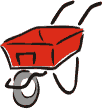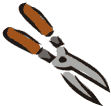 Back Care for Gardeners Gardening, one of the greatest pleasures for many people, is becoming easier and less likely to be the backbreaking hobby it has been in the past providing certain guidelines are followed. Back pain sufferers need to take extra care when gardening. Try to remove the need for the back breaking physical labour required to maintain lawns, borders and flower beds. Great care must be taken when moving pots and tubs of soil - always seek help or use a mechanical aid. Sensible planting can reduce a lot of the hard work involved in gardening.Plant low maintenance shrubs and perennials where less accessible areas exist.
Back Care for Gardeners Gardening, one of the greatest pleasures for many people, is becoming easier and less likely to be the backbreaking hobby it has been in the past providing certain guidelines are followed. Back pain sufferers need to take extra care when gardening. Try to remove the need for the back breaking physical labour required to maintain lawns, borders and flower beds. Great care must be taken when moving pots and tubs of soil - always seek help or use a mechanical aid. Sensible planting can reduce a lot of the hard work involved in gardening.Plant low maintenance shrubs and perennials where less accessible areas exist.
 Choose plants for ground cover and reduce the need for continuous weeding. Where this is unsuitable, cover the soil with forest bark, mushroom compost or a thick layer of peat. This will help prevent weeds and conserve moisture. Raised beds are an excellent idea for those with chronic back problems. The recommended width for a raised bed is a maximum of 4 ft and approximate height of 2-3 ft. If purpose-built raised beds are impractical use old sinks, water tanks, oil drums, tubs and boxes. Have the beds raised to the correct height by using bricks or paving. Do not attempt to lift and carry heavy items such as boxes or tubs, always seek assistance or use a mechanical aid.
Choose plants for ground cover and reduce the need for continuous weeding. Where this is unsuitable, cover the soil with forest bark, mushroom compost or a thick layer of peat. This will help prevent weeds and conserve moisture. Raised beds are an excellent idea for those with chronic back problems. The recommended width for a raised bed is a maximum of 4 ft and approximate height of 2-3 ft. If purpose-built raised beds are impractical use old sinks, water tanks, oil drums, tubs and boxes. Have the beds raised to the correct height by using bricks or paving. Do not attempt to lift and carry heavy items such as boxes or tubs, always seek assistance or use a mechanical aid.
 Make sure that the workbenches in greenhouses are built to the correct height, usually 2 to 4 inches below the height of your elbow, so that bending is reduced. Of course you can sit down, at the right height, to work thus reducing the strain of standing in one position for too long. Do not sit on a low stool which forces you to stretch and overreach.
Make sure that the workbenches in greenhouses are built to the correct height, usually 2 to 4 inches below the height of your elbow, so that bending is reduced. Of course you can sit down, at the right height, to work thus reducing the strain of standing in one position for too long. Do not sit on a low stool which forces you to stretch and overreach.
 The sensible use of well-designed tools can be an enormous help in reducing the possibility of back pain. However, never buy any equipment without trying it for weight, height, balance and of course, suitability for the job. Most good garden centres will have a wide selection of tools and will be glad to give advice and information. Several manufacturers make spades and forks which have handles of various lengths and there are ranges of clip-on tool heads for the longer handles.
The sensible use of well-designed tools can be an enormous help in reducing the possibility of back pain. However, never buy any equipment without trying it for weight, height, balance and of course, suitability for the job. Most good garden centres will have a wide selection of tools and will be glad to give advice and information. Several manufacturers make spades and forks which have handles of various lengths and there are ranges of clip-on tool heads for the longer handles.
 Look for lightweight, long handled spades and forks and hoes with push and pull action to reduce strain on the back. There are specially designed tools with a spring and lever action which cut out a lot of the hard backbreaking digging. Multi-functional petrol units are available for the tougher jobs. If possible, buy automatic, rewinding hosepipes and electric leads.
Look for lightweight, long handled spades and forks and hoes with push and pull action to reduce strain on the back. There are specially designed tools with a spring and lever action which cut out a lot of the hard backbreaking digging. Multi-functional petrol units are available for the tougher jobs. If possible, buy automatic, rewinding hosepipes and electric leads.
![]() GARDEN TASKS
GARDEN TASKS
Digging is probably the heaviest task in most gardens.Over enthusiastic digging, by out of condition gardeners, accounts for a high proportion of those who end up with 'horticultural' back pain. Before you actually start in the garden do some warm-up exercises to get your muscles ready for the task ahead. Weeding and planting can be dangerous tasks when the back is bent and stretched too far and for too long. Choose a long-handled hoe made from stainless steel for less friction.
 Plant from a kneeling position. Use 'kneeler seats' with handles or mats, not low seats Mowing and pruning require the right tool for the job. Beware when using hover mowers. Always work behind them. Never attempt to move them sideways by swinging from the waist with the mower at arm's length. Choose the machine to match grass and size of garden.
Plant from a kneeling position. Use 'kneeler seats' with handles or mats, not low seats Mowing and pruning require the right tool for the job. Beware when using hover mowers. Always work behind them. Never attempt to move them sideways by swinging from the waist with the mower at arm's length. Choose the machine to match grass and size of garden.
Where possible choose an electric start mower or an all electric mower. Mow a little at a time keeping as upright as possible.
 Start up a petrol mower by bracing the foot against the machine for balance and then pull the cord. Use long-handled shears to trim edges. When pruning use secateurs which have cut and hold action.
Start up a petrol mower by bracing the foot against the machine for balance and then pull the cord. Use long-handled shears to trim edges. When pruning use secateurs which have cut and hold action.
Do's and Don'ts
DO
- Do choose a lightweight, long handled garden tool.
- Do wear loose, comfortable clothing.
- Do keep your back straight while lifting the soil.
- Do exert force through knees.
- Dig a little at a time.
- Do take a break every 10-20 minutes.
DON'T
- DON'T Don't strain, twist or reach too far in front.
- Don't take huge spadefulls.
- Don't be too proud to use a small spade.
- Don't dig continuously.
- Don't overload the wheelbarrow.
- Don't stoop or work too far in front of you.
- Don't stretch or squat with a bent back.
- Don't bend too far or twist to the side when starting the mower.
- Don't overstretch or swing Flymo's mowers from side to side.

 Every time I saw her I had new things to report that I had managed to do as my range of movement gradually increased and the pain and stiffness lessened.
Every time I saw her I had new things to report that I had managed to do as my range of movement gradually increased and the pain and stiffness lessened.
